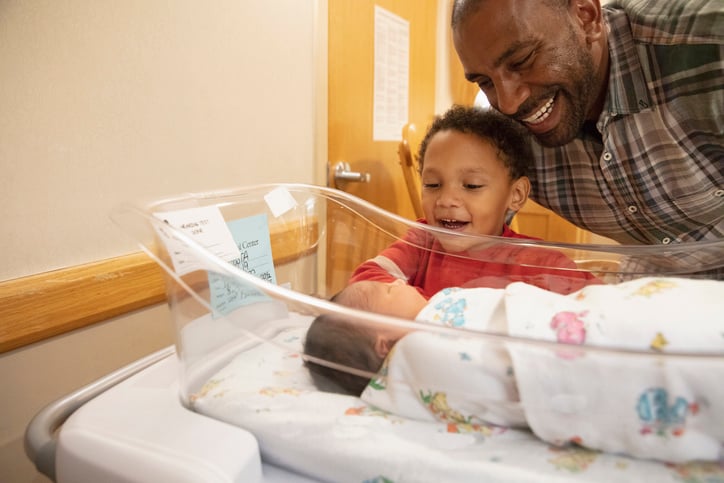8 Tips for Helping Autistic* Children Prepare for a New Baby
Preparing for the arrival of a new baby often involves a significant adjustment period as the family acclimates to schedule changes and reallocates some of their time, attention, and resources to get ready for the logistical and emotional challenges that adding a new family member will bring.
For children on the autism spectrum, adapting to these changes can be significantly harder. Shifts in schedule, daily routine, and the amount of attention received from one’s parents during this time may result in heightened autistic symptoms, including:
- Increased anxiety, frustration, and sensory sensitivities
- Repetitive behaviors–like stimming, rocking, or rubbing one’s feet or hands together
- Reduced social interactions and limited engagement with others
- A desire to engage in special interests–such as playing with a favorite set of toy cars or action figures
- Deficits or regression in executive function (EF) skills–including focusing one’s attention, organizing, planning ahead, allocating working memory, and self-monitoring behaviors and emotions
- A preference for sameness, familiarity, and predictability in one’s daily schedule and routine
Although children with autism might face considerable challenges when adjusting to changes that coincide with the arrival of a new family member, these difficulties can often be prevented by designing an individualized plan to support the child’s needs from the outset.
Getting Ready for the New Arrival
There are many ways to help autistic children prepare for the arrival of a new sibling, and most strategies involve supporting the child in making adjustments to their daily routines and personal expectations ahead of time. It is often wise to guide, assist, and help the child prepare for changes that a newborn may bring to the family prior to arrival day. This can be accomplished by doing the following:
- Make the necessary modifications, adjustments, or schedule changes with your child before the new baby comes home.
- Use social narratives and video models to prepare your child with autism for upcoming transitions and unfamiliar situations.
- Have your child play with a toy doll to help them learn to appropriately hold, touch, and care for a baby.
- Create a daily activity schedule to implement with your autistic child before the arrival of the newborn.
- Initiate behavior analytic services for your child on the spectrum.
- Show pictures, videos, and books with other newborns to your child.
- Plan for divided attention between you, your child with autism, and the new baby.
- Familiarize your child with other caregivers or family members who can step in when the new baby is born or when a break is needed.

1. Start helping your child make any necessary modifications, adjustments, or schedule changes before the new baby arrives.
If possible, set up the baby’s room and crib in advance. Allow your child with autism to ask any specific questions they may have about the arrival of their new brother or sister, and give them an opportunity to explore some of the areas and spaces where their sibling will frequently be. Help your child understand that the newborn might create interruptions to their current routine, and support your child in adapting to those changes as they arise.
2. Use social narratives and video models to prepare your child for upcoming transitions and model appropriate responses to unfamiliar situations.
Video models and social narratives are effective approaches for visualizing new situations and circumstances before they take place in real life. These strategies can be helpful for showing a child what to do when a new baby cries loudly, is sleeping, or needs to be fed. Advance preparation provides an opportunity to anticipate and respond to new situations.
Examples of social narratives and video modeling resources that can be used for practice and education include:
3. Consider having your child play with a toy doll to help them learn to appropriately hold, touch, and care for a baby.
Purchase a life-like doll that makes noises and can be cared for like an actual child. Depending on the age and developmental level of your child with autism, this strategy can also be used for parents wishing to teach safety skills to their children.
4. Create a daily activity schedule to implement with your child before the arrival of the newborn.
By providing a reliable routine for your child on the spectrum, consistency and predictability will be accounted for–even before the baby arrives. These factors are often important to autistic children, and a daily activity schedule with visual cues can be a productive approach for ensuring that your child knows what to expect their day-to-day life to look like. Carefully implement any anticipated adjustments that will need to be adapted to when the newborn comes home.
Additionally, using “first/then” statements may help your child understand a sequence of tasks or activities that need to be accomplished before doing something else. You might, for instance, require your child to clean up from their snack first before allowing them to watch some of their favorite TV shows.
5. Set up behavior analytic services for your child on the spectrum.
Applied behavior analysis (ABA) is an effective approach that supports children with autism in reaching their personal goals for success. Using evidence-based techniques, behavior analysts can create an individualized plan to help your child transition to changes–such as coping with lifestyle and routine adjustments after a new baby comes home.
While behavior analytic services can be received in a treatment, clinic, community, or school setting, it might be most helpful to find a home provider who will develop a plan for your child to manage their emotions, behaviors, and reactions in the home environment when the new baby arrives. You can find an ABA service provider in your area using this search tool.
6. Show pictures, videos, and books with other newborns to your child.
If a friend, family member, or acquaintance has a young child or baby, consider planning a “meet-and-greet” day to visit them. This opportunity will help prepare your autistic child for what to expect when their new sibling comes home.
Additionally, picture books with illustrations may support your child in preparing to meet the new baby. Some popular books for welcoming a newborn include:
- The New Baby (Little Critter) by Mercer Mayer
- Baby on the Way and What Baby Needs by the Sears Children’s Library
- Waiting for Baby, My New Baby, You and Me, and Look at Me! stories by Rachel Fuller
- The Berenstain Bears’ New Baby by Stan and Jan Berenstain
7. Plan for divided attention between you, your child with autism, and the new baby.
There is no question that infants require a significant amount of time, energy, attention, and resources–especially in the first several months of their life. With this in mind, prepare your child with autism for a change in the amount of time you will be able to dedicate directly to them.
It may also be beneficial to set aside some time to spend with your older child each week. During this time, have another parent or caregiver in charge of looking after the newborn; this will ensure that interruptions are limited and your child receives quality one-on-one time with you.

8. Familiarize your child with other caregivers or family members who can step in when the new baby is born or a break is needed.
Parents need a break too! Therefore, try to schedule a consistent time for this to take place. Make sure your child feels comfortable with the caregiver or family member that they will be with, and consider planning a time to meet the caregiver ahead of time–before leaving your child with them. Write out the daily schedule and verbally discuss each component with the caregiver to help keep your child’s routine as close to normal as possible.
In Summary
Preparing for the arrival of a new baby is difficult for most families, but–for those with a child on the autism spectrum–the adjustment process can be much harder. Considering this, it is important to implement some changes in advance to help your child prepare for what to expect when their new sibling comes home. Acclimating to adjustments ahead of time will help the transition take place more smoothly.
Please let us know in the comments what other ways you have found to help a child with autism prepare for the arrival of a new baby.
Also, be sure to check out our free checklist handout on strategies to help a child with autism prepare for a new sibling!
This article was based, in part, on the following sources:
https://360behavioralhealth.com/how-to-prepare-a-child-with-autism-for-a-new-sister-or-brother/
https://kidmunicate.com/autism-social-stories-preparing-to-be-a-big-brother-or-sister/

Kenna McEvoy
Kenna has a background working with children on the autism spectrum and enjoys supporting, encouraging, and motivating others to reach their full potential. She holds a bachelor's degree with graduate-level coursework in applied behavior analysis and autism spectrum disorders. During her experience as a direct therapist for children on the autism spectrum, she developed a passion for advocating for the health and well-being of those she serves in the areas of behavior change, parenting, education, and medical/mental health.




